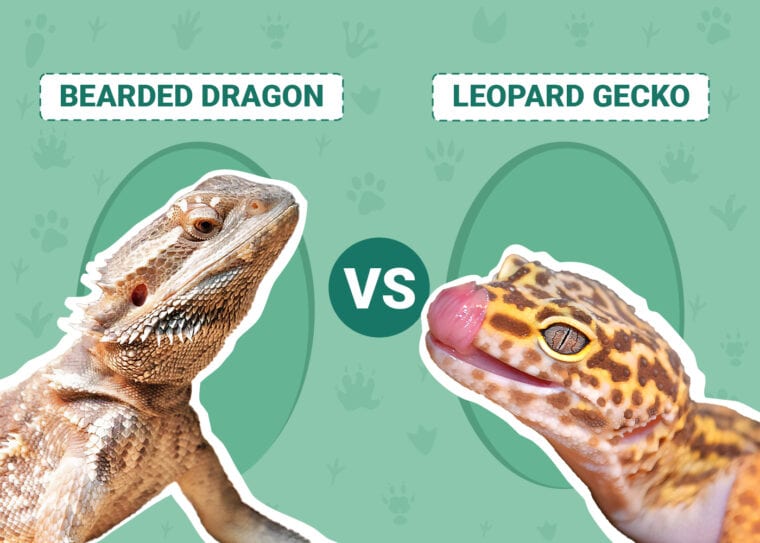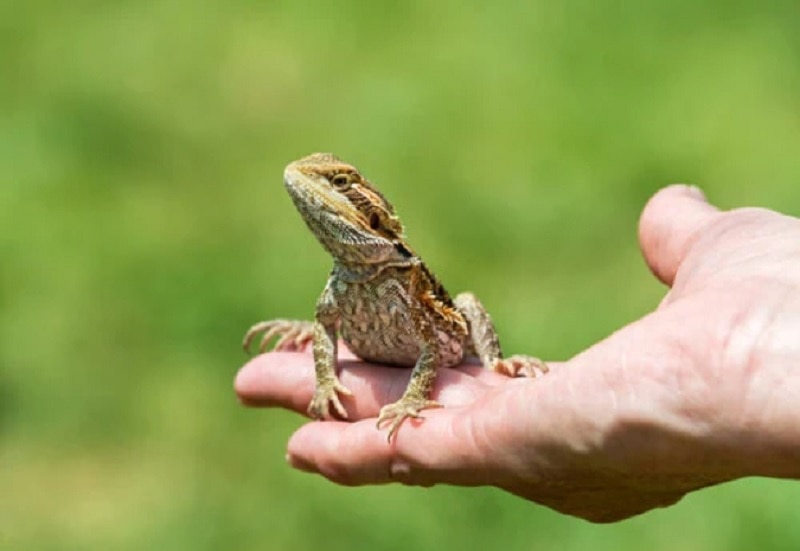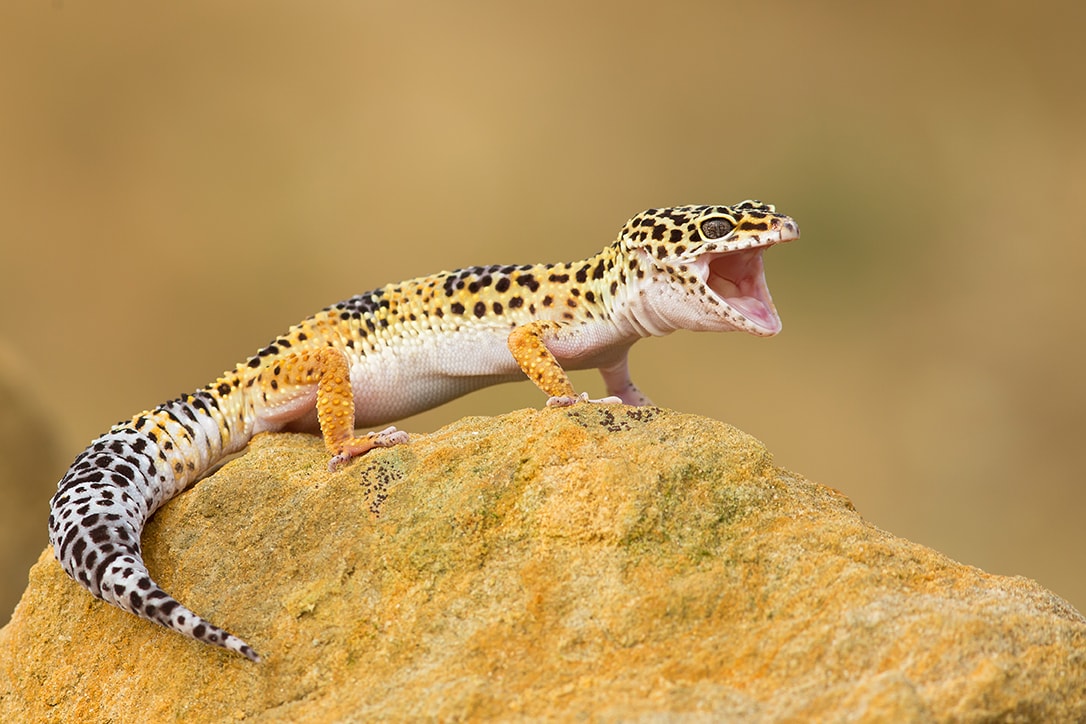
Click to Skip Ahead
If you have ever considered getting a reptile but were overwhelmed by the high level of care many of them require, then bearded dragons and leopard geckos may be good starter reptiles for you. Both of these types of reptiles are docile and curious, making them great pets for children and adults alike. Although they have relatively simple care for reptiles, there are important factors to take into account when deciding if you are ready for a reptile in your home.
Bringing home a reptile is a decision that should be given serious thought, especially since both bearded dragons and leopard geckos have long life expectancies. Given a healthy environment by an educated owner, both can make wonderful, interactive pets. Let’s discuss how they differ and what considerations should be given to each.
Visual Differences

At a Glance
Bearded Dragon Overview

Tank Considerations
As reptiles, bearded dragons are cold-blooded, so they require a heat source to regulate their body temperature. They are desert-dwelling creatures and prefer a dry, arid climate, but may require additional moisture during sheds. There are many enclosure options for bearded dragons, and some people even prefer to make their own.
Substrate & Flooring
Even though they are from the desert, it is not recommended to give bearded dragons sand as their tank substrate. They can accidentally consume sand, leading to intestinal impactions. This is especially common in juveniles. Newspaper, butcher paper, and reptile carpeting are considered the safest substrate options. Paper products can be replaced daily to maintain cleanliness.
Lighting
Bearded dragons do require both full spectrum lighting and a heat lamp for their enclosure. Heating mats, pads, or rocks are not recommended as they can lead to burns on the dragon’s belly. Ensure the pet always has access to water in a shallow dish. It’s best to also provide a food bowl to reduce food-related messes and insects escaping into the enclosure.

Health & Care
Bearded dragons are curious and playful reptiles and greatly appreciate an enriching environment. This can be accomplished through frequent rotations of different items and textures as well as toys, especially those that fulfill their desire to hunt like small balls and other things they can chase. It is important to ensure they cannot swallow anything put in their enclosure. They also enjoy exploring outside their enclosure and some stores sell special harnesses and leashes made specifically for bearded dragons.
Diet
Bearded dragons are omnivorous, with juveniles requiring more insects and adults requiring more plants. A balanced diet can be achieved through a combination of packaged pre-made foods specifically for bearded dragons, live and freeze-dried insects, leafy greens, and other fruits and vegetables in small quantities as occasional treats. Like many reptiles kept as pets, bearded dragons are prone to calcium deficiencies and may require supplementation. Many pet stores sell reptile calcium supplements with appropriate dosing instructions on them.
Environment
Bearded dragons having difficulty with sheds may require bath soaks, with commercial products available for this purpose. One option is to place them in the bath in a small, enclosed container with adequate breathing holes. This creates a sauna-like environment and the combination of the soak and the humidity can help loosen the stuck skin.
Health Concerns
Many veterinarians trained in the care of exotic pets will see bearded dragon patients that require medical interventions. These vets can be found through local internet searches and recommendation sites. The Association of Reptile and Amphibian Veterinarians is a good resource for finding a veterinarian in your area who deals with reptiles. This site can be found at www.arav.org

Temperament/Personality
Bearded dragons are docile and enjoy being handled by people, especially those that they know. They can get along with other animals, but interactions with other animals should only be done under strict supervision for safety. Bearded dragons are playful and will develop preferences for enrichment activities as well as food.
Suitable for:
Bearded dragons make great pets for children who have adult oversight in the care of the pet. They also are suitable for adults, whether a new reptile keeper or experienced professional. They can spend time outdoors with supervision but should not live outdoors. Bearded dragons are suitable for someone looking for a reptile that will enjoy time out of its enclosure and going on walks.
Leopard Gecko Overview

Tank Considerations
Leopard geckos are small, even at full adult size, so they do not require a large amount of space. They can be kept in enclosures as small as 20 gallons, but a larger tank is ideal for ease of care and enrichment. An important aspect of their tank setup is that they require a warm side with a warming mat and a cool side with a small amount of damp material to ensure there is humidity in the cool side of the tank.
Lighting
Leopard geckos are nocturnal so they will prefer an environment with places to hide, like rock caves. Keeping a day/night cycle is best for them, but they do not require specific tank lighting. This cycle can be achieved through regular indoor lighting or rooms with natural light.
Substrate & Flooring
Like bearded dragons, leopard geckos may accidentally consume sand used as substrate, so it is advised against in juveniles and is not the best substrate choice for adults. While reptile carpet can be used, the best tank flooring is tile, slate, or linoleum. These can easily be wiped down, will help insulate heat, and will not absorb humidity. Leopard geckos need access to water in a shallow dish and a food bowl to keep insects in place, but the hard tank flooring will help reduce messes from eating and drinking.

Health & Care
Leopard geckos need a stimulating and enriching environment, which can usually be accomplished by different hides, textures, and climbing sticks. They do not usually play with toys like bearded dragons will. Most of them will be happy in their enclosure or with some handling, but likely would be stressed by being taken outdoors.
Diet
Leopard geckos are strictly insectivores, so their dietary needs are met exclusively by insects. Examples include crickets and mealworms, among others. These insects are fed supplements that “gut load” them, making them more nutritious for the gecko. Some leopard geckos may require calcium supplementation, which can be achieved through reptile calcium supplements.
Environment
Due to their need for humidity, leopard geckos will often shed without issue. During sheds, they usually will require additional humidity and misting, and on some occasions may require bath soaks to help loosen stuck skin.
Like bearded dragons, leopard geckos can usually be cared for by a veterinarian with exotics training. Using the Association of Reptile and Amphibian Veterinarians website will be a beneficial tool in finding a vet if needed for a leopard gecko.

Temperament/Personality
Leopard geckos are docile and friendly, but do not enjoy being handled as much as bearded dragons. They will enjoy or tolerate small amounts of handling, but too much can cause stress which can lead to health problems. They do exhibit individual personalities and seeing these come out over time can be an enjoyable experience.
Suitable for:
Leopard geckos are one of the easiest reptiles to care for, so they make suitable pets for children and adults. It is important to help children remember to limit the handling of the gecko and adult oversight on maintaining the tank needs is necessary. Leopard geckos are suitable for someone looking for a pet that will often prefer looking to touching.
Which Breed Is Right for You?
Bearded dragons and leopard geckos both can make excellent pets for people new to reptile ownership, but the differences in their care and personalities can make the decision a little easier. People looking for an interactive pet that will go on small adventures with them would likely appreciate a bearded dragon. People looking for a pet that is interesting and fun to watch would likely appreciate a leopard gecko. Both pets are a long-term commitment and do require specific care that can be a lot to take on as a new pet owner, but with the right guidance owning either of these pets can be a fun and educational experience for anyone willing to take on the responsibility.
Featured Image Credit: Top – Brooke Whatnall, Shutterstock | Bottom – torstensimon, Pixabay










